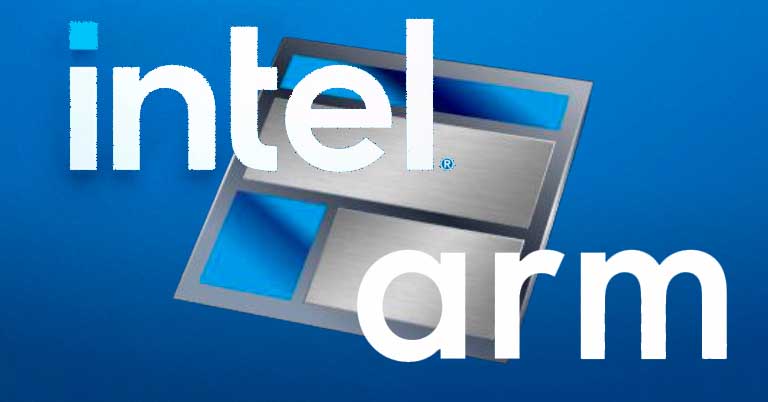
Intel has just announced a multi-generation collaboration with Arm, the top IP licensor for mobile chipsets. This multi-generational deal will initially concentrate on manufacturing Arm-based mobile chips before expanding to applications in the automotive, IoT, data center, aerospace, and government sectors.
Intel Foundry x ARM
It’s no secret that the recent years have not been good for Intel with delays on its 10nm and 7nm process nodes—letting its archenemy AMD thrive in the market. So in 2021, Intel announced IDM 2.0 strategy under which the company devised a new Foundry Service decision to manufacture chips for other clients. It even announced to invest USD 20 billion into building two new boundaries for the same.
The new design technology co-optimization (DTCO) between IFS and ARM is part of this strategy. This doesn’t mean Intel will be fabricating chips for ARM. Instead, it opens the door for fabless companies to build chips using ARM’s IP design and Intel’s open foundries.
This agreement also puts Intel directly against TSMC and Samsung Semiconductors, the leading manufacturers of all smartphones chips today. TSMC, in particular, has helped rivals AMD and NVIDIA to get Intel’s market share.
- You might also like:
- Intel announces Arc Pro A60 and A60M GPUs for professional workstations
- Apple’s switch from Intel (x86) to Arm: Everything you need to know
- Samsung will continue its multi-year partnership with AMD
- Qualcomm aims to take on Apple, AMD, and Intel with its “Oryon” CPU
Intel 18A Process
Intel’s foundry will manufacture Arm chips for smartphones using the 18A process, which Intels hopes will go into mass production in 2024. The 18A process is essentially a 1.8nm technology. The “A” in 18A stands for the metric unit named Angstrom, which measures one-tenth of a nanometer (0.1 nm).

Intel 18A promises two new changes: RibbonFET and PowerVia. The former is the new transistor architecture that will replace the FinFET, which Intel has been using since 2012. It brings ribbon-shaped channels with gate all around that allows for higher performance, greater control, and a compact form factor.
With PowerVia, intel will power transistors in chipsets directly from underneath. This is more efficient than placing the power cables on top and frees up the space on top for signal routing.
Why this deal, though?
Both sides will benefit from this partnership. Intel will benefit from Arm’s expertise in low-power and high-performance chips, while Arm will gain access to Intel’s advanced manufacturing and research capabilities. This joint effort may bring the SoC‘s size to miniature more than ever and increase the efficiency of the next-gen chips.
“Intel’s collaboration with Arm will expand the market opportunity for IFS and open up new options and approaches for any fabless company that wants to access best-in-class CPU IP and the power of an open system foundry with leading-edge process technology”, says the CEO of Intel.
Hence, the partnership between Intel and Arm might bring a whole new level to the field of smartphone chips.
- Meanwhile, check out our comparison of the latest flagship smartphone chipsets.







![Best Gaming Laptops in Nepal Under Rs. 250,000 (रु 2.5 Lakhs) [2025] Best Gaming Laptops Under 2.5 lakhs in Nepal [Feb 2025 Update]](https://cdn.gadgetbytenepal.com/wp-content/uploads/2025/02/Best-Gaming-Laptops-Under-2.5-lakhs-in-Nepal-Feb-2025-Update.jpg)
![Best Gaming Laptops in Nepal Under Rs. 120,000 (रु 1.2 Lakhs) [2025] Best Budget Gaming Laptops Under Rs 120000 in Nepal 2025 Update](https://cdn.gadgetbytenepal.com/wp-content/uploads/2025/05/Best-Budget-Gaming-Laptops-Under-Rs-120000-in-Nepal-2024-Update.jpg)
![Best Laptops Under Rs. 80,000 in Nepal [2025] Best Laptops Under 80,000 in Nepal March 2025 Update](https://cdn.gadgetbytenepal.com/wp-content/uploads/2025/03/Best-Laptops-Under-80000-in-Nepal-March-2025-Update.jpg)
![Best Gaming Laptops in Nepal Under Rs. 200,000 (रु 2 Lakhs) [2025] Best gaming lapotp under 2 lakhs Nepal Feb 2025](https://cdn.gadgetbytenepal.com/wp-content/uploads/2025/01/Best-Gaming-Laptops-Under-2-Lakh-Nepal-Feb-2025-Update.jpg)

![Best Mobile Phones Under Rs. 15,000 in Nepal [Updated 2025] Best Phones Under 15000 in Nepal 2024 Budget Smartphones Cheap Affordable](https://cdn.gadgetbytenepal.com/wp-content/uploads/2024/03/Best-Phones-Under-15000-in-Nepal-2024.jpg)
![Best Mobile Phones Under Rs. 20,000 in Nepal [Updated] Best Mobile Phones Under NPR 20000 in Nepal 2023 Updated Samsung Xiaomi Redmi POCO Realme Narzo Benco](https://cdn.gadgetbytenepal.com/wp-content/uploads/2024/01/Best-Phones-Under-20000-in-Nepal-2024.jpg)
![Best Mobile Phones Under Rs. 30,000 in Nepal [Updated 2025] Best Phones Under 30000 in Nepal](https://cdn.gadgetbytenepal.com/wp-content/uploads/2025/01/Best-Phones-Under-30000-in-Nepal.jpg)
![Best Mobile Phones Under Rs. 40,000 in Nepal [Updated 2025] Best Phones Under 40000 in Nepal 2024 Smartphones Mobile Midrange](https://cdn.gadgetbytenepal.com/wp-content/uploads/2024/02/Best-Phones-Under-40000-in-Nepal-2024.jpg)
![Best Mobile Phones Under Rs. 50,000 in Nepal [Updated 2025] Best Phones Under 50000 in Nepal](https://cdn.gadgetbytenepal.com/wp-content/uploads/2025/01/Best-Phones-Under-50000-in-Nepal.jpg)
![Best Flagship Smartphones To Buy In Nepal [Updated] Best flagship phone 2025](https://cdn.gadgetbytenepal.com/wp-content/uploads/2024/07/Best-Flagship-Phones-who-is-it-ft-1.jpg)